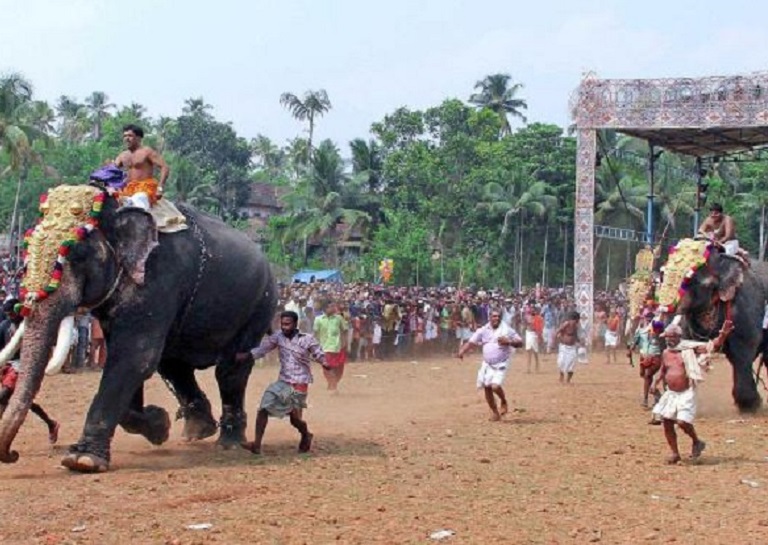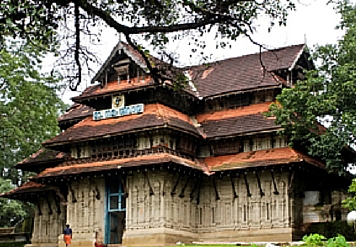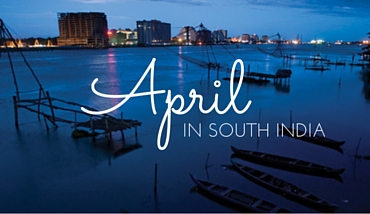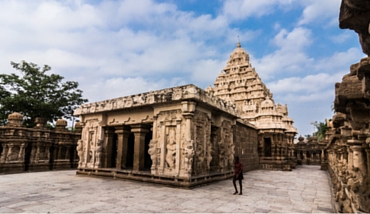- Events
- Apr 07,2016
- Post Comments
Arattupuzha Pooram: A conclave of Gods

Jeevan Krishnakumar
Chief Explorer

Kerala is one of those festival-crazy parts of the world. Throughout the year, you will find events where grandeur prevails over the simplicity of day to day life. The ‘Pooram season’ in central Kerala (March – April) is one such time when multiple small and large events fill up the local calendar. The Arattupuzha Pooram is the one of the grandest of such traditional festivities which have passed on through generations.
For a Keralite, the local village festival is about how deep your roots are sunk into the place of your birth.

The quaintness of rituals, the time honoured traditions, the colours of festivities and sense of community are its biggest draw of festivals

In this write up, I share my personal travel experience to the Arattupuzha Pooram. I also provide some background on the festival and along the way share some practical travel planning tips. So here it goes.
Experiencing the Arattupuzha Pooram: My Travelogue
The memories of my first temple festival experience are so fresh: Walking around our village grounds as a 7-year-old clinging on to my father’s hand into the sea of humanity. It was unlike anything I had experienced as a London brought up kid. The energy, colour and feel etched into my memories.
Throughout my childhood, I was magnetically drawn towards these quaint temple traditions. It was this urge that took me local village festivals, town temples to even pulling all-nighter at famous events like Vaikom Ashtami or ‘7 and half golden elephants’ of Ettumanoor festival. It is safe to say that I grew up festival crazy!

That evening was something special. For the Pooram lover in me, the very prospect of experiencing the genesis of all temple festivals had me thrilled. And that I was also going to share this experience with travellers across the seas made it even more special.

I met Therese and Kelly (travellers from Australia) at their hotel in Thrissur and joined them for an early dinner. We already had a bit of context as I had helped them in their planning stage to work their trip around the Arattupuzha pooram event. We chatted up on the myth, lore and legends around what we are about to experience. Their excitement knew no bounds, as did mine.
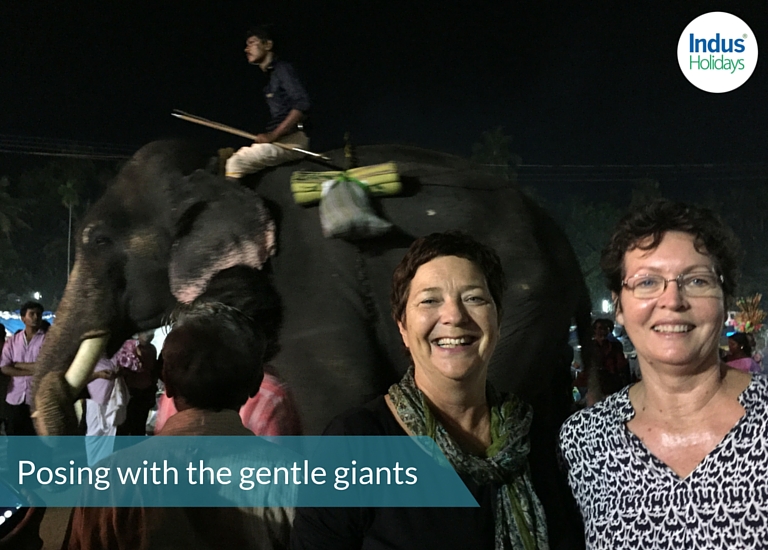
By around 7:30 pm, we started from Thrissur to Puthukad. We made our way through narrow country roads lighted up with tubes and crossed the bridge over the Arattupuzha river. As we walked into the grounds, we saw the tower lighting decorations at a distance. Mountains of bananas, mouth-watering aroma of murukku, rows of glittering bangles, toys, trinkets and yards of jasmine. The calls of vendors, fortune-tellers, performances of stunt artists and parrot card readers. “Finally, the India described in travelogues” commented Kelly.
It was a colourful sight to see traditionally dressed hindu families, groups of youngsters and moplah girls joining in the festivities. The confusion of it all stirred some interesting conversations. Therese was curious about the setting and the people at the venue. I helped them appreciate the more intricate aspects of it. What reflected in the parambe (grounds) were vignettes of village life in Kerala and the communal harmony it creates.


Never mind what God you believe in, at the Pooram ground everyone belongs to one fraternity. This is the lure of a festival ground.

As we moved closer to the venue, we could see elephants being transported in trucks to the main venue. They were getting ready for the night poorams. As per custom, the elephant goes inside the temple for Pooja before joining in the main festivities or “Melams”. From a distance, we could slowly hear the beats of the Chenda (Drum made of cow skin) and the Kuzhal (A long double reed wind instrument).
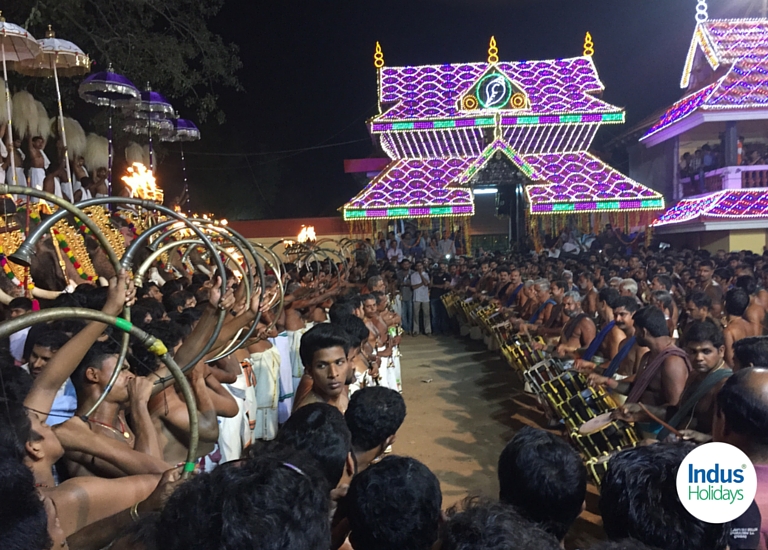
A sea of humanity was now visible. We were in time for witnessing the famous Shastavinte Melam - the grand assembly of 200 odd percussion artists which begins the overnight celebration. We made our way through to the centre of action. After a patient wait, we chanced on the best vantage point around - the base of the Banyan tree bang at the heart of the celebration. A spectacular view a couple of feet above the crowds. Of course it took a lot of pandering to the ‘Thrissur’ spirit to hold on to that much coveted spot ;)
The melam was in full swing - men atop majestic pachyderms in a festival array opposite the crowds. They were engaged in a ceremonial display of “Muthukudas” (sequined, glittering umbrellas) and swaying of “Venchamarams” (white whisks). “Theevetti” - huge flame bearing staffs and traditional lighting brought in an old-world charm to the arena. In front of this the drummers brought to beat their chendas, cymbals clashed, the Kombu (trumpet) and Kuzhal (pipe) artist synced the tune. The performers were ushered on by the thousands who waved their hands in tune with the rhythm.
With the vigour of mystic beings, the performers twisted, gyrated and twirled, raising clouds of dust with their swirling feet. When they stopped abruptly, there is an unnerving silence which allowed us to soak-in the energy of it all. Once again the orchestral extravaganza came alive with its pagan rhythm.

As a part of the pooram inebriated multitudes, we let the festival’s spirit permeate us through and through.

At a least a couple of hours had passed in the midst of it all. The Pooram continued in sessions. Knowing that there was more to explore on the grounds, we slowly waded our way out of the crowds. A welcoming gentle breeze made us realise we are drenched in sweat. The grounds were also the venue for many folk art forms. It was enjoyable to watch the performance with vibrant costumes, dance and songs all woven together by a thin plot.
.jpg)
Just as we regained a sense of calm, the pyrotechnics started. An array of iron cylinders kept on the ground filled with gunpowder. When one was lit, the spark from it set the next one off. This boom-boomlay was the most awaited “Vedikettu”. It sounded more like a war field but for on-lookers the night sky bore an unparalleled spectacle. The explosions shook the grounds, filled our ears and rocked within our heart. This was the cultural cherry on the festival cake if I may call it so.
By the time we recovered from it, the drums in the background were back for yet another session of deafening music. It was time for us to leave, we felt a slight weakness. As we walk back, more elephants in trucks are just coming in. The event was apparently just warming up. Multiple small and big melams were scheduled for the night culminating in the Devasangamam (Conclave of gods with 60+ elephants) and Arattu (holy bath of idols) which would go on till dawn.
At the end of it all, the body is tired but I still can’t sleep. My mind lingers on the after thoughts - I witnessed something unbelievable and I feel humbled by the sheer vigour of it all. The power of community brought in multitudes upon multitudes of people together to create something truly remarkable. It probably was a shout out to claim our humanity in these deeply individual-oriented times.
Are you planning to visit some of the famous temples of Kerala? Our custom tour around this circuit might interest you.
Understanding the Aratupuzha Pooram - Stories, Myths and Event flow
If my travel experience was able to get your curiosity, a deeper understanding of the stories, myths and facts around this event would certainly be of interest to you. The reality is that my travelogue covers only a part of the festival called Shastavinte Melam. The event is much bigger and has so much more depth to it. Here, we try to break it down, with some facts and the event flow. Read on as more of it unravels!
The Arattupuzha Pooram is the oldest temple festival celebrated in India
As per the inscriptions on the temple in Aratupuzha, the ritual started around 1400 years ago. This is its claim to fame as the mother of all poorams and you can see that all other poorams are connected to this event in some way. The Arattupuzha Sree Shastha Temple, which forms the venue for the annual celebration is three thousand years old.
The festival is seven days long with elephant races and many quirky rituals before the overnight celebration on the last day which is the most popular
What is popularity called Arattupuzha Pooram is the overnight celebration which comprises of Sasthavinte melam, Devasangamam and Arattu. There is actually quite a lot more happening: Five days prior to the Shastavinte Melam (the event we witnessed), with the Thiruvathira Purappad, the temple deity is taken out of the Sanctum Santorum to witness the Pooram at Thaikattussery temple. Along with many other elaborate rituals, on the day prior to Aaratupuzha Pooram, an elephant race is conducted on the grounds of the Pidikkaparambu temple. On the morning of the Aaratupuzha Pooram, the sastha takes part in the Thottippal Pooram and returns by evening to the temple for the overnight celebration we witness.
It is among the fewer night poorams and Shasthavinte melam is the largest assembly of percussion artists of its kind
Poorams have a different feel and grandeur in the night. This is a special attraction of The Arattupuzha Pooram. The major events start on the last day evening with the Sashtavinte Melam (what we witnessed). Among the largest percussion art performances of its kind and the fireworks after it attracts a huge crowd to the venue.
The Devasangamam or ‘Conclave of Gods’- the pooram with 60 elephants is the grandest part of the celebration
After the Shastavinte Melam, the Devasangamam is the event highlight. The festival is about the welcoming all Gods who come for the annual visit of the Shastha. On the Pooram night, deities from 23 temples from different parts of Thrissur take part in the celebration. The local deities accompanied by their elephants keep flowing in throughout the night. The final event (a couple of hours before sunrise) is at the nearby paddy field where 60 elephants assemble bearing coloured umbrellas and parasols accompanied by traditional orchestra making for a majestic spectacle.
The most sacred ceremony is ‘Aarattu’ or holy bath- the event to which the temple owes its name to
After the Devasabha as we near dawn, elephants carry the deities gathered at the Sree Sastha temple to the nearby river. The is where the ‘Aarattu’ or holy bath takes place. The idols are immersed in the river with ceremonial chanting and the entire proceedings is accompanied by traditional torches, melams and floral offerings. The event concludes with the customary truck rise by the elephant carrying the deities. A sight worth seeing.
It is endearing to see traditions of such depth being passed on through generations of Keralites. While some changes are bringing in challenges like number of elephants reducing (from 120 or so fifty years ago to 60 nowadays) and space constraints, the spirit of the festival survives. That is what matters the most.
Information on Arattupuzha Pooram 2017
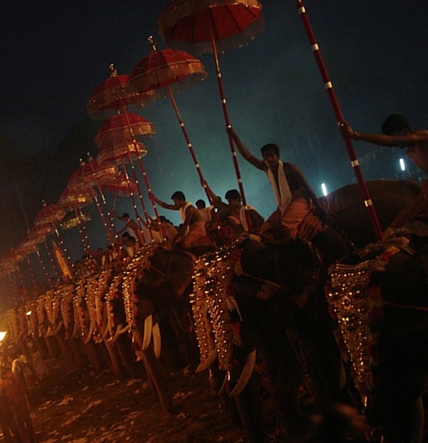
Access
For All
Arattupuzha Pooram (2017)
This event is closer to the end of the larger temple festival season in kerala is one of the most famous ones
Venue: Arattupuzha Temple, Thrissur (15 km from town)
Date/Timing: April 9, 2017 from 7 pm
Duration: Overnight celebration
Amongst the most culturally immersive temple experiences you can expect as traveller to Kerala
How to get there:
Thrissur is the nearest town and it is well connected by trains, but Ernakulam (Kochi) has better connectivity by both air and bus. Overnight buses to Thrissur from Bangalore, Chennai, Hyderabad and other cities can be booked via state run operators (www.ksrtc.in) and through www.redbus.in. The venue is away from Thrissur so you may need to arrange local transport for that.
How to book a trip with this event:
If you are coming exclusively for the event and not touring other parts of the state, you can stay at Thrissur. There are no formal arrangements for tourists to experience this event. It is open to all and anyone can walk in. Here are some of our suggestions:
If you are familiar with people and have some context on the local way of life by all means walk-in, you will enjoy the experience. If you are travelling in from a totally different background, hire a local person to accompany you on this trip. It can be pretty overwhelming. More importantly, you will miss the details which is most important when you experience something as unique as this.
Have us plan your trip
A trip planned by us will suit travellers who want a more personal/behind the scenes experience. We connect you with local families, traditional homes and work your entire trip so as to include this event in the tour. More importantly, we also take you on historic routes of the Muziris heritage zone and its connects with the Arattupuzha Pooram.
Would you like us to plan a journey through time and a culturally immersive custom-curated tour for Arattupuzha Pooram. Click for further details.
We hope the above information will help you take an informed decision for your tour planning to Kerala. Feel free to get in touch for any help. Below we have shared some tips to make your Arattupuzha pooram experience better.
What to Expect and Top tips
From our experience of organising trips for travellers to many poorams including Arattupuzha Pooram, here are a few suggestions we have that you might find useful.
- We recommend that you reach thrissur at least by afternoon so you can rest some time which will help stay longer and pull an all-nighter to see the event in it full glory
- On the night of the pooram, arrive early and be at the venue before 7 pm. This is because connectivity to the venue gets clogged as the event nears commencement.
- Don’t expect any organised facility for tourists. There are a few good vantage points around but you will have to make arrangements well in advance to get them.
- Carry a lot of water but nothing more to the venue, you are likely to lose stuff you carry into the crowds.
- Here is a pro tip: Pander to the Thrissur spirit and the fact that you have travelled far to join in, people will make way for you.
Have Loads of fun
We hope this information served as a helping hand in your travel planning to Kerala. It is not every day that you get to see 200 odd percussion artists, 60 odd elephants, holy rituals, fire crackers and a sea of humanity immersed in it all. So come along and tell us how it was. Happy travelling!
Related Tour Packages
Related articles
New Articles
-
1
Apr 23,2019
Nehru Trophy Boat Race 2019: Booking Options
-
2
Apr 19,2019
Nehru Trophy Boat Race: The essential guide
-
3
Jan 19,2019
Everything you need to know about an Ayurveda Holiday in Kerala
-
4
Aug 10,2018
Thinking about Kerala for your next holiday? Start right here!
-
5
Jul 09,2018
Ten secrets to a fascinating backwater experience: Discover it!
Send An Enquiry
WE ARE SOCIAL, LET’S CONNECT

